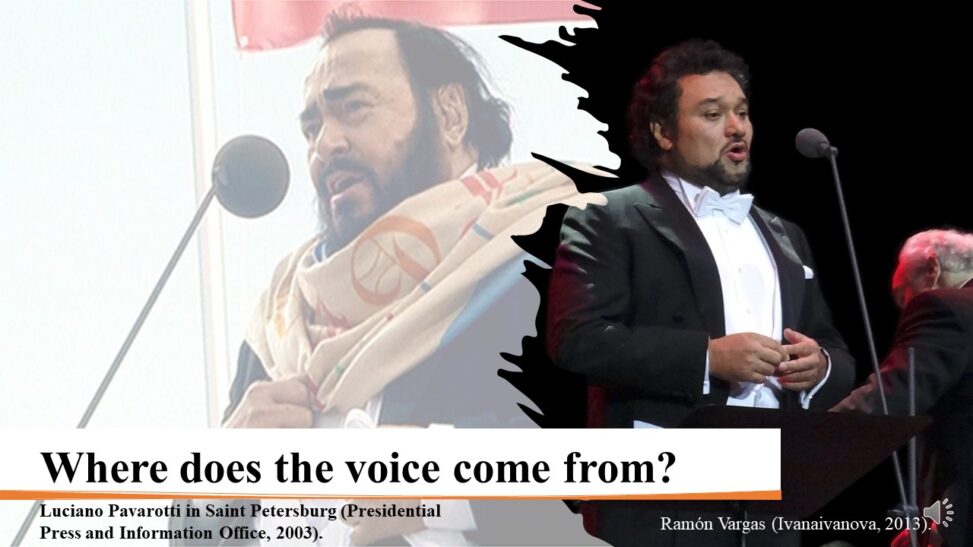You may have been heard that abdominal breathing is important for singing with a steady and beautiful voice, or that someone has a nasal voice after catching a cold. But where does the act of producing speech actually take place?
目次
Process of Pronunciation
There are three processes of producing sound: initiation, phonation, articulation, and the each process occurs in the lungs*, vocal cords, and oral or nasal cavities.
*Some initiation occur in other organs than the lungs.
Initiation
When the ribs open and the diaphragm lowers, the lungs expand and the air enters into them. On the contrary, when the ribs close and the diaphragm rises, the lungs contract and the air is pushed out from them. This expansion and contraction of the lungs generates airflow, and that is the “initiation”.
The term “thoracic respiration” is sometimes used to describe breathing especially when the ribs move widely in the respiration, while the term “abdominal respiration” is used to describe breathing when the diaphragm moves widely. However, in both cases, it is the expansion and contraction of the lungs that creates the airflow.
Although it is quite rare, the initiation of some speech sounds caused by organs other than the lungs.
Phonation
The airflow generated in the lungs passes through the vocal cords. This is called “phonation”.
Sounds with vocal cords vibration are called voiced sounds, while sounds without vocal cords vibration are called voiceless sounds.
The vibration of the vocal cords can be further classified as whispers, breathy voices, creaks, etc.
Articulation
After passing through the vocal cords, the voice is controlled by the various articulators in the oral or nasal cavity. This is called “articulation”.
Articulations are further classified according to their manners and places. We will discuss this point in the next article.
Summary
In this article, we explained the process of pronunciation.
- Initiation: making airflow
- Pulmonic: airflow pushed out of the lungs by the movement of the ribs and diaphragm
- Non-pulmonic: airflow caused by other organs than lungs
- Phonation: airflow passing through the vocal cords
- Voiced: with vocal cords vibration
- Voiceless: without vocal cords vibration
- Articulation: articulators controlling the voice
We will discuss more about articulation in a future article. Please take a look as well, if you like.
References and Images
Including items used in the video.
•Gal, P. (2008, May 13). File:Throat Diagram.png – Wikimedia Commons. https://commons.wikimedia.org/wiki/File:Throat_Diagram.png
•Gray, H. (1918a). File:Gray855.png – Wikimedia Commons. https://commons.wikimedia.org/wiki/File:Gray855.png
•Gray, H. (1918b). File:Gray956.png – Wikimedia Commons. https://commons.wikimedia.org/wiki/File:Gray956.png
•Ivanaivanova. (2013, January 23). File:Ramón Vargas.JPG – Wikimedia Commons. https://commons.wikimedia.org/wiki/File:Ram%C3%B3n_Vargas.JPG
•Jorge Hernández Valiñani. (2007, April 12). File:Cheerleader Waseda.jpg – Wikimedia Commons. https://commons.wikimedia.org/wiki/File:Cheerleader_Waseda.jpg
•Oxford University Press.(2022).OED Online.
•Presidential Press and Information Office. (2003, May 31). File:Luciano Pavarotti in Saint Petersburg.jpg – Wikimedia Commons. https://commons.wikimedia.org/wiki/File:Luciano_Pavarotti_in_Saint_Petersburg.jpg
•Toutios, A., Lingala, S. G., Vaz, C., Kim, J., Esling, J., Keating, P., Gordon, M., Byrd, D., Goldstein, L., Nayak, K., & Narayanan, S. (2019, January 17). span | the rtMRI IPA charts.
•川原繁人. (2020). 三省堂(川原 2018).http://user.keio.ac.jp/~kawahara/sanseido.html
•公益財団法人日本国際教育支援協会. (2021年11月5日). 日本語教育能力検定試験の出題範囲の移行について. http://www.jees.or.jp/jltct/pdf/R4syutsudai.pdf
•Other images are stock images from Microsoft PowerPoint

